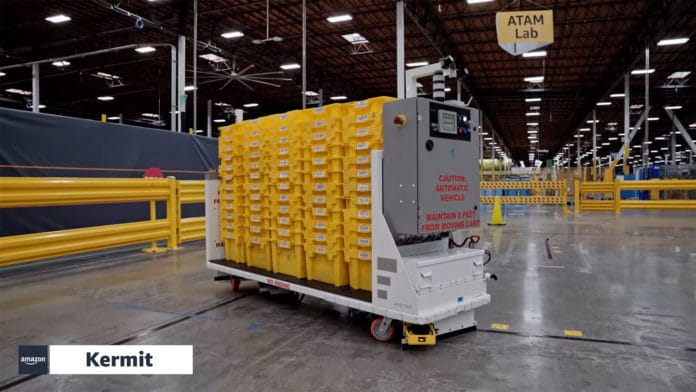Amazon’s Robotics and Advanced Technology teams are rigorously testing and developing new technologies to help move totes, carts, and packages through Amazon warehouses, helping to make employees’ jobs safer and reduce accidents.
The online shopping giant is testing four autonomous robots to move items through its logistics centers with little intervention. The robots will allow workers to focus on tasks that need their attention and move away from those that can cause injuries. This decision is part of Amazon’s goal of reducing incident rates by 50% at its facilities by 2025.
The robot “Ernie” is trained to help remove items from a robotic shelf – something that doesn’t save time, but it does create a safer situation for employees. Ernie takes totes off of a robotic shelf and uses a robotic arm to deliver them to employees, so they can remain in a more comfortable, stable, and ergonomically friendly position. For its part, “Bert” is an autonomous mobile robot (AMR) that is designed to navigate the premises independently, so it can carry carts and goods from one place to another. Amazon believes that Bert might at some point be able to move larger, heavier items or carts that are used to transport multiple packages through its facilities.
In addition, Amazon has “Scooter” and “Kermit,” two other AMR robots in development that transport carts. The Scooter carries carts like a train, while the more truck-like Kermit hauls empty tote boxes using magnetic tape and tags to shape its path. The company currently plans to deploy Scooter to at least one Amazon facility this year and is already testing Kermit in several other sites.
In addition to new robots, Amazon also introduced a “motion-capture software” to study typical warehouse tasks with a mind toward redesigning equipment and workflows. “With this data, visualizations, and employee feedback, we are looking to identify relatively simple changes that can make a big impact,” said Kevin Keck, worldwide director of Advanced Technology at Amazon. “Something as simple as changing the position of handles on totes may help lower the risk of injuries to our employees at a massive scale.“
These advancements are more about making human tasks more comfortable. “The role robotics and advanced technology can play in not only innovating for customers, but helping make our facilities safer, is a massive motivation for me and my team,” said Keck. “The health and safety of our employees is our number one priority. By listening to them, innovating on their behalf, and driving new technologies into our facilities over the coming months and years, I’m confident we’ll make a big contribution to our goal of reducing recordable incidents by 50% by 2025.“
